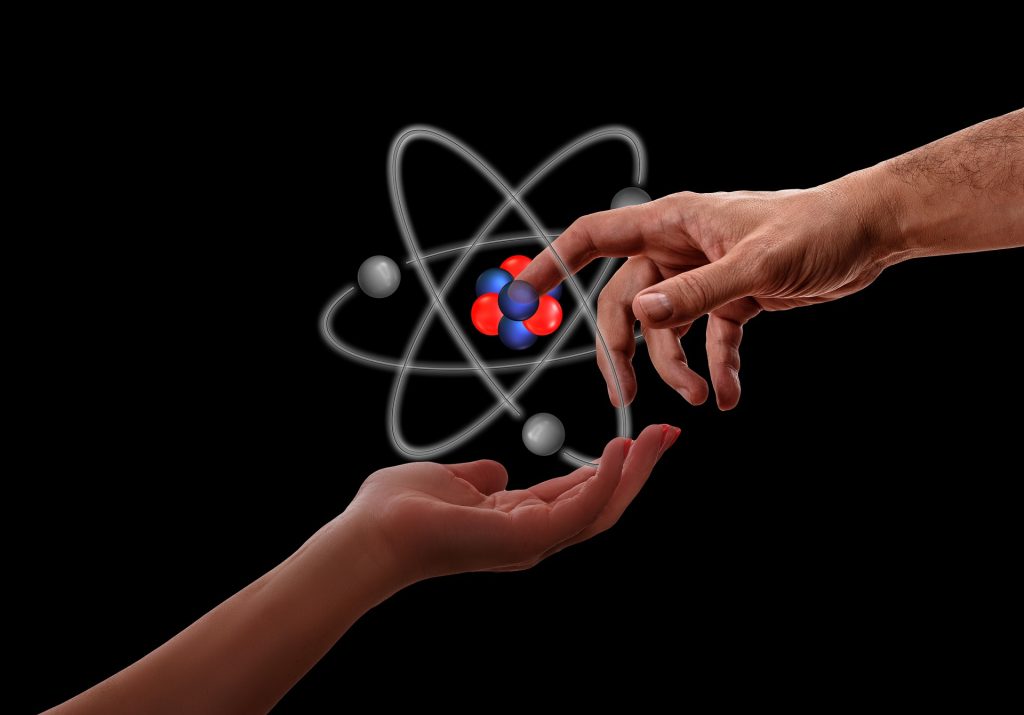The word fundamental generally means independent and unique or neutral. In very general terms, fundamental force is the original or independent force, i.e. those forces which do not originate from any other force or form of any other force but all other forces that originate from it or only the transformation of these forces are called fundamental forces.
Arranging the four fundamental forces in nature in the order of weakness, we get-
- Gravitational force
- Weak nuclear force.
- Electromagnetic force.
- Strong nuclear force.
Gravitational Force
The force of attraction between any two objects in the universe is called gravitational force. Isaac Newton gave this idea in his Philosophia Naturalis Principia Mathematica in 1687 AD. He was the first to give a mathematical explanation of the gravitational force known as Newton’s law of gravitation. However, in modern physics, gravity is most clearly described by the general theory of relativity. According to Einstein, the gravitational force is created due to the curvature of space-time. However, scientists believe that this force works through the mutual exchange of a particle called graviton between two objects. This force of attraction was not only discovered by Newton but was successfully applied in establishing the laws of the solar system.

Newton’s law of gravitation is: “Each particle of this universe attracts each other, the value of this attractive force is proportional to the product of the mass of the two particles and is proportional to the square of the distance between them. This force acts along the straight line connecting their centers.”
Gravitational force is a well-known force in everyday life because it imparts weight to any object with mass, causing the object to fall to the ground when dropped. Earth and other planets revolve around the sun due to gravity. We feel weight due to the force of gravity. Needless to say, this gravitational force is the weakest among the four fundamental forces of nature. For example, the gravitational force between a proton and an electron in a hydrogen atom is only 3.6×10^(-47)N while the electrostatic force between the two particles is about 2.5×10^(-8)N.
However, this force can become quite important if the two objects have very large masses. For example Sun and Earth. That means gravity will act between two objects that have mass. The reason it is so important to us, even though it is weak, is that this force has an infinite range and this force is always attractive. But the other three forces of nature are sometimes attractive and sometimes repulsive. This leaves a possibility that they cancel each other out, which is not the case with gravity. And because of this, even though the force of gravity is the least powerful, its effect is everywhere. Now we are talking about how the force of gravity is active between two objects and why its range is more.
From the point of view of quantum mechanics, the force between two matter particles is carried by a massless, uncharged particle called a graviton with spin 2 (which particles look like they did when rotated through a semicircle i.e. 180 degrees. For example, a king or queen card of a card). which we have already seen. And since this particle has no mass, the force (gravitational force) carried by this particle will be very long, that is, it can exchange force over a long distance. It is said that the gravitational force between the sun and the earth is caused by the mutual exchange of particles called gravitons. In this case, the graviton is also called a messenger particle, although it is an imaginary particle. What classical physicists used to call gravitational waves are gravitons.
However, since gravitational waves are so weak, they have never been detected or observed. This gravitational force can explain everything from the fall of an object to the ground to the formation of black holes and galaxies at high altitudes. The gravitational force was first explained mathematically. Although Newton discovered the universal law of gravitation, he could not explain its source or cause. He believed that the religions of ‘space’ and ‘time’ are eternal-inert and are not affected by the presence or absence of energy. His idea was that gravity is the religion of matter (inertness), not related to space and time in any way. Einstein later explained with the help of general theory that matter is not an inherent religion of matter. Gravity is not a force like other forces. It is simply a product of the curvature of space-time caused by the presence of matter. Therefore, starting from Aristotle to Galileo, Newton explained the force of gravity, but the basis of our current understanding of this is Einstein’s principle of relativity.
Electromagnetic Force
A type of force of attraction or repulsion between two charged objects or between two magnetic materials is called electromagnetic force. Meanwhile, an atom or a molecule gets stability through the interaction of these forces. This force is responsible for chemical reactions. Through the work of scientists and theoretical physicists like Coulomb, Faraday, and Ampere, the nature of induced magnetic force was revealed. Maxwell perfected the nature of this force by placing it on a mathematical model. Maxwell was the first to establish electricity, magnetism, and light energy as a single entity. That is, electricity and magnetism are two different properties, but they are discussed together because one of them can produce the other. When electric currents or charges move, they create a magnetic field.

Again the changing magnetic field creates the electric field. The effective limit of this force is infinite, the carrier of the force is a zero-mass constant photon particle. The induced magnetic force obeys the parity symmetry of the reactance. A photon is a massless, fictitious particle with spin 1 (which when rotated 360 degrees looks like an ace of cards) that serves as the messenger particle in the magnetic field. And because this force is carried by massless particles, its range also extends to infinity.
Weak Nuclear Force
We know that there are some elemental particles in nature (with atomic mass greater than 82) whose nuclei break apart spontaneously. Which is known as radioactivity and all these nuclei are called radioactive nuclei. During the decay, these nuclei emit some rays known as radioactive rays. In 1899, Rutherford and Villard, with the help of various experiments, stated that they are positively charged alpha, negatively charged beta, and uncharged gamma. When a beta particle is emitted from a radioactive nucleus, some amount of energy is also emitted, which is slightly more than the kinetic energy of the beta particle.
Now the question comes, if the beta particle carries a small part of this energy, then what is the source of the rest of the energy? In 1930, W. Pauli proposed that the remaining energy was carried by another type of particle that was emitted along with the beta particle. This particle is called neutrino. These beta particles and neutrinos form a weak nuclear force. Let’s see an example,

The total number of nucleons in a Caesium atom is 137. That is, the total number of protons and neutrons in it is 137. The total number of protons in cesium is 55. Now if “somehow” a neutron can become a proton, there is no change in the total number of nucleons, since one proton increases to 56, the atom will no longer be a cesium atom. It will then become a barium atom with atomic number 56. And what is responsible for this is the weak nuclear force. During this change or decay an electron anti-neutrino will be emitted along with an electron. But the interesting thing is that it takes a long time for scientists to understand this weak force.
Strong Nuclear Force
As we know, an atomic center or nucleus is composed of charged particles protons, and neutral particles neutrons. The force that holds the protons and neutrons inside the nucleus and gives stability to the nucleus is called the strong nuclear force. It is extremely strong and charge-neutral. In other words, protons are active between protons, neutrons are active between neutrons, and protons and neutrons are equally active. Its effectiveness is very short distance stretching only within distances in the Fermi (10-15) range.
It is essentially an attraction but can appear as a repulsion at a certain distance. It is required for the stability of the nucleus.
Now let us consider a helium atom. Its nucleus has two protons and two neutrons. Besides, two electrons are orbiting outside the nucleus. We know from Coulomb’s law in the field of magnetism that like charges will repel each other and opposite charges will attract each other. But if you look closely, only two protons are sitting in the helium nucleus, which has the same charge and the outer orbital electrons are also attracting these positively charged protons. Still, they are not moving away from each other, they are not repelling each other. That is, here a stronger force than the Coulomb force is acting at a very short distance. which allows two identical protons to coexist. This is where the strong nuclear force is at work, which is the strongest of the four fundamental forces.
This force is believed to be created as a result of the exchange of a particle with spin 1 called a meson between nucleons (protons and neutrons). As long as this meson exchange continues, the nucleons can hold each other. However, for this meson exchange to occur, the nucleons must be very close because we already know that the strong nuclear force acts over a very short distance. And this distance is one meter which is equal to the radius of a nucleus. Only at this distance will the nucleons be held together by the strong nuclear force. But if the distance is greater than this, the strong nuclear force will no longer act. Then the magneto-magnetic force will win and due to its effect, there will be repulsion between the nucleons.
Consolidation of the Force
Although Maxwell had already unified the electric and magnetic forces, almost 100 years later, in 1961, Sheldon Glasho presented a theory to unify the ferromagnetic and weak nuclear forces. But it was incomplete. Later two scientists named Salam and Weinberg gave the fullness of this theory which became known as “Electroweak Interaction” or “Moved-Magnetic Interaction”.
Writer
Jeion Ahmed
Chittagong, Bangladesh



I was very pleased to uncover this great site. I need to to thank you for ones time for this fantastic read!! I definitely appreciated every bit of it and I have you bookmarked to look at new information on your blog.
Thank you
Really I got it and also appreciated from you.
[…] discovered that when an object is immersed in a liquid or gas, the object appears to lose some weight. For example, if you cannot lift a tree stump when it is on the ground, you can easily lift it when […]
Thank you
Really I got it and also appreciated from you.